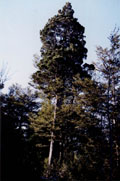
Mature tree in habitat [Trevor Hinchliffe].

Sapling: Natural regeneration near Kaueranga Visitor Center [C.J. Earle, 2003.03.01].
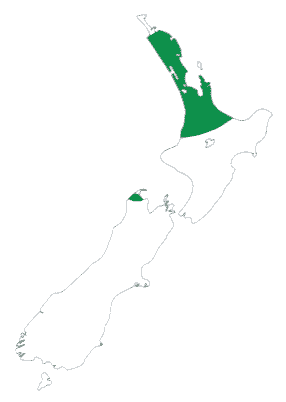
Distribution map (Metcalf 2002).
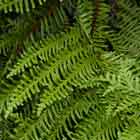
Foliage on the sapling shown above [C.J. Earle, 2003.03.01].
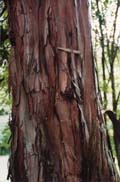
Bark on a tree in Waipoua Forest [Trevor Hinchliffe].

Bark on a 3 cm diameter stem at Kaueranga [C.J. Earle, 2003.03.01].
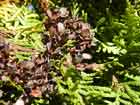
Foliage and cones on a young open-grown tree in Cornwall Park, Auckland [C.J. Earle, 2003.03.12].

Conservation Status

Libocedrus plumosa
(D. Don) Sargent 1896
Common names
Kawaka, New Zealand cedar.
Taxonomic notes
Syn: Dacrydium plumosum D. Don 1828; Thuja doniana Hooker 1842; Libocedrus doniana (Hooker) Endlicher 1847 (Farjon 1998).
Description
A tree 18-25(-31) m tall and usually 60-120 cm dbh. Crown conical, of heavy, almost horizontally spreading branches atop a long bare bole. Bark red-brown, shed in thin strips. The branchlets are fern-like in the regularity of their parallel pinnate divisions. On juvenile trees the branchlets are up to 7 mm wide and quite flattened. On adult trees they are narrower, about 3 mm wide and not quite so flattened. The juvenile leaves are very unequal, the lateral leaves up to about 5 mm long, the facial leaves about 0.8 mm long. Adult leaves less unequal, the lateral leaves about 3-5 mm long, overlapping and appressed more closely than the juvenile leaves; facial leaves about 1.25-2.5 mm long, triangular. Pollen cones, produced from the tips of short branchlets, are 5-8 mm long, linear, with 8-12 sporophylls. Seed cones are woody, ovoid, 10-15 mm long, the 4 scales each with a curved, projecting dorsal mucro. Seeds 2, 1 to each fertile scale. Wood dark red with dark streaks running through the even grain (Allan 1961, Dallimore et al. 1967, Salmon 1996, Metcalf 2002). See García Esteban et al. (2004) for a detailed characterization of the wood anatomy.
Distribution and Ecology
New Zealand: N and S Is from lat. 35°S to beyond lat. 38°S, between Collingswood and Westhaven (Allan 1961). In the North Island, from Mangonui to about Rotorua and northern Taranaki. It grows from sea level to 600 m in lowland and hilly forests (Salmon 1996, Metcalf 2002). Hardy to Zone 8 (cold hardiness limit between -12.1°C and -6.7°C) (Bannister and Neuner 2001).
Remarkable Specimens
No data as of 2023.02.28.
Ethnobotany
See Conifers of New Zealand for a review of the historic role of forests in native and European cultures of New Zealand.
The wood is fine-grained, often beautifully marked, dark red in colour, durable, easily worked, and thus suitable for furniture as well as general building work. It was formerly used for roofing shingles and general building purposes, but is too scarce to be of much commercial value (Dallimore et al. 1967, Metcalf 2002).
Observations
In general this is not a dominant tree, and I have not heard that it forms pure stands. I have seen it as a young tree in the vicinity of the Kaueranga Visitor Center, about 15 km east of Thames on the Coromandel Peninsula. It is called out as being a significant component of the vegetation in Te Huruhi Reserve on Waiheke Island, near Auckland, and it also grows as an ornamental in Auckland, for instance in Cornwall Park. It is also recorded for Waipoua Forest, although I did not see it there, and Trevor Hinchliffe (e-mail, 2003.02.20) reports big trees in the forests at Taranaki, at the foot of the mountain.
Remarks
Citations
Allan, H. H. 1961. Flora of New Zealand. Volume I, Indigenous Tracheophyta. Wellington: R.E. Owen Government Printer.
See also
Elwes and Henry 1906-1913 at the Biodiversity Heritage Library (as Libocedrus doniana). This series of volumes, privately printed, provides some of the most engaging descriptions of conifers ever published. Although they only treat species cultivated in the U.K. and Ireland, and the taxonomy is a bit dated, still these accounts are thorough, treating such topics as species description, range, varieties, exceptionally old or tall specimens, remarkable trees, and cultivation. Despite being over a century old, they are generally accurate, and are illustrated with some remarkable photographs and lithographs.
Farjon (2005) provides a detailed account, with illustrations.
Gymnosperms of New Zealand.
The New Zealand Plant Conservation Network, accessed 2010.11.22.







